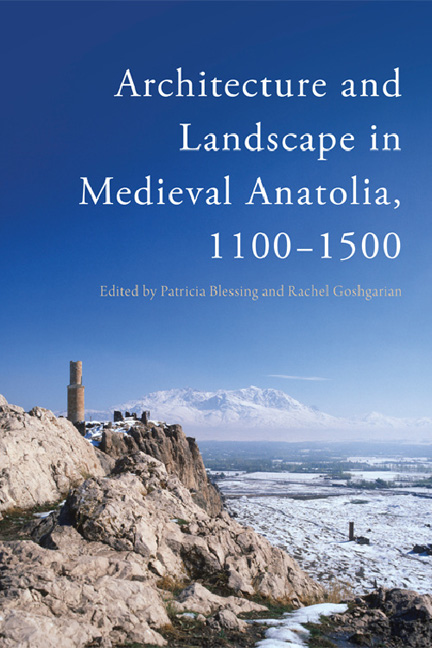Book contents
- Frontmatter
- Contents
- List of Illustrations and Tables
- Acknowledgements
- Foreword
- Map
- 1 Introduction – Space and Place: Applications to Medieval Anatolia
- Part I Building: Masons and Infrastructure
- Part II Social Groups: Akhis and Futuwwa
- Part III Exchange: Islamic and Christian Architecture
- 6 Transformation of the ‘Sacred’ Image of a Byzantine Cappadocian Settlement
- 7 The ‘Islamicness’ of Some Decorative Patterns in the Church of Tigran Honents in Ani
- Part IV Frameworks: Language, Geography and Identity
- Notes on Contributors
- Bibliography
- Index
7 - The ‘Islamicness’ of Some Decorative Patterns in the Church of Tigran Honents in Ani
from Part III - Exchange: Islamic and Christian Architecture
Published online by Cambridge University Press: 03 January 2018
- Frontmatter
- Contents
- List of Illustrations and Tables
- Acknowledgements
- Foreword
- Map
- 1 Introduction – Space and Place: Applications to Medieval Anatolia
- Part I Building: Masons and Infrastructure
- Part II Social Groups: Akhis and Futuwwa
- Part III Exchange: Islamic and Christian Architecture
- 6 Transformation of the ‘Sacred’ Image of a Byzantine Cappadocian Settlement
- 7 The ‘Islamicness’ of Some Decorative Patterns in the Church of Tigran Honents in Ani
- Part IV Frameworks: Language, Geography and Identity
- Notes on Contributors
- Bibliography
- Index
Summary
The Church of Saint Gregory the Illuminator (also called of Tigran Honents) and its zhamatun, located in the city of Ani in northeastern Turkey, display architectural features that are uncommon in Armenian architecture. Uncommon, at least, in the early thirteenth century when the monastic complex to which the church belonged was erected in the northeastern section of the city, on a sheer edge overlooking the Akhurian River. Some of these features, such as the use of muqarnas, would become familiar in later Armenian architecture, especially for decorating the ceilings of gavits and the zhamatuns of churches. Some unusual elements – including the muqarnas, but also arabesque decorative patterns – betray an Islamic nexus. Among the factors explaining their appearance in the city of Ani, the increasing Islamisation of the architectural landscape of the area certainly played a role. This phenomenon followed the Islamisation of the society, which was itself precipitated by Muslim settlement. Ani itself had two mosques erected within its walls, while Seljuk patronage started dotting eastern Anatolia with Islamic buildings, both religious and secular.
Some literature on this topic written at the beginning of the twentieth century casts the intrusion of Islamic features in Armenian architecture into a scheme according to which barbarous peoples from eastern Asia (Seljuk Turks) brought decline and debasement to older, well-rooted architectural traditions. Such a linear narrative, however, does not take into account how these non-traditional (from an ‘Armenian’ point of view) architectural features were perceived when they were used beyond the Islamic realm, including in areas considered Armenian territory. Though tracking down the perception of an architectural form in thirteenth-century eastern Anatolia is a rather difficult task, a detailed analysis of the kind of patterns and techniques that were selected and the scope of their circulation at the time of their appearance in the city of Ani might offer some evidence on the process of adoption of ‘foreign’ forms into a wellestablished architectural tradition. Finally, a focus on the church's patron as well as on the contemporaneous socio-political context helps us to suggest a nuanced view of an artistic phenomenon otherwise reduced to a simple matter of the ‘influence’ of Islamic architecture on the Armenian one.
- Type
- Chapter
- Information
- Architecture and Landscape in Medieval Anatolia, 1100-1500 , pp. 155 - 182Publisher: Edinburgh University PressPrint publication year: 2017



